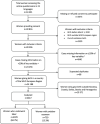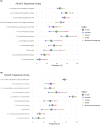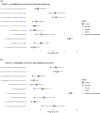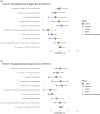Women's perspectives on the quality of hospital maternal and newborn care around the time of childbirth during the COVID-19 pandemic: Results from the IMAgiNE EURO study in Slovenia, Croatia, Serbia, and Bosnia-Herzegovina
- PMID: 36530003
- PMCID: PMC9877897
- DOI: 10.1002/ijgo.14457
Women's perspectives on the quality of hospital maternal and newborn care around the time of childbirth during the COVID-19 pandemic: Results from the IMAgiNE EURO study in Slovenia, Croatia, Serbia, and Bosnia-Herzegovina
Abstract
Objective: To assess the quality of maternal and newborn care (QMNC) in countries of the former Yugoslavia.
Method: Women giving birth in a facility in Slovenia, Croatia, Serbia, and Bosnia-Herzegovina between March 1, 2020 and July 1, 2021 answered an online questionnaire including 40 WHO standards-based quality measures.
Results: A total of 4817 women were included in the analysis. Significant differences were observed across countries. Among those experiencing labor, 47.4%-62.3% of women perceived a reduction in QMNC due to the COVID-19 pandemic, 40.1%-69.7% experienced difficulties in accessing routine antenatal care, 60.3%-98.1% were not allowed a companion of choice, 17.4%-39.2% reported that health workers were not always using personal protective equipment, and 21.2%-53.8% rated the number of health workers as insufficient. Episiotomy was performed in 30.9%-62.8% of spontaneous vaginal births. Additionally, 22.6%-55.9% of women received inadequate breastfeeding support, 21.5%-62.8% reported not being treated with dignity, 11.0%-30.5% suffered abuse, and 0.7%-26.5% made informal payments. Multivariate analyses confirmed significant differences among countries, with Slovenia showing the highest QMNC index, followed by Croatia, Bosnia-Herzegovina, and Serbia.
Conclusion: Differences in QMNC among the countries of the former Yugoslavia during the COVID-19 pandemic were significant. Activities to promote high-quality, evidence-based, respectful care for all mothers and newborns are urgently needed.
Clinicaltrials: gov Identifier: NCT04847336.
Keywords: Bosnia-Herzegovina; COVID-19; Croatia; IMAgiNE EURO; Serbia; Slovenia; childbirth; maternity; newborns; quality of care.
© 2022 The Authors. International Journal of Gynecology & Obstetrics published by John Wiley & Sons Ltd on behalf of International Federation of Gynecology and Obstetrics.
Conflict of interest statement
The authors have no conflicts of interest to declare.
Figures






Similar articles
-
Women's perspectives on the quality of maternal and newborn care in childbirth during the COVID-19 pandemic in Latvia: Results from the IMAgiNE EURO study on 40 WHO standards-based quality measures.Int J Gynaecol Obstet. 2022 Dec;159 Suppl 1(Suppl 1):97-112. doi: 10.1002/ijgo.14461. Int J Gynaecol Obstet. 2022. PMID: 36530013 Free PMC article.
-
Women's assessment of the quality of hospital-based perinatal care by mode of birth in Romania during the COVID-19 pandemic: Results from the IMAgiNE EURO study.Int J Gynaecol Obstet. 2022 Dec;159 Suppl 1(Suppl 1):126-136. doi: 10.1002/ijgo.14482. Int J Gynaecol Obstet. 2022. PMID: 36530009 Free PMC article.
-
Rates of instrumental vaginal birth and cesarean and quality of maternal and newborn health care in private versus public facilities: Results of the IMAgiNE EURO study in 16 countries.Int J Gynaecol Obstet. 2022 Dec;159 Suppl 1(Suppl 1):22-38. doi: 10.1002/ijgo.14458. Int J Gynaecol Obstet. 2022. PMID: 36530007 Free PMC article.
-
Factors that influence the provision of intrapartum and postnatal care by skilled birth attendants in low- and middle-income countries: a qualitative evidence synthesis.Cochrane Database Syst Rev. 2017 Nov 17;11(11):CD011558. doi: 10.1002/14651858.CD011558.pub2. Cochrane Database Syst Rev. 2017. PMID: 29148566 Free PMC article.
-
Debriefing interventions for the prevention of psychological trauma in women following childbirth.Cochrane Database Syst Rev. 2015 Apr 10;2015(4):CD007194. doi: 10.1002/14651858.CD007194.pub2. Cochrane Database Syst Rev. 2015. PMID: 25858181 Free PMC article.
Cited by
-
Quality of maternal and newborn care in Switzerland during the COVID-19 pandemic: A cross-sectional study based on WHO quality standards.Int J Gynaecol Obstet. 2022 Dec;159 Suppl 1(Suppl 1):70-84. doi: 10.1002/ijgo.14456. Int J Gynaecol Obstet. 2022. PMID: 36530005 Free PMC article.
-
Health workers' perspectives on the quality of maternal and newborn health care around the time of childbirth: Results of the Improving MAternal Newborn carE in the EURO Region (IMAgiNE EURO) project in 12 countries of the World Health Organization European Region.J Glob Health. 2024 Sep 6;14:04164. doi: 10.7189/jogh.14.04164. J Glob Health. 2024. PMID: 39238363 Free PMC article. Clinical Trial.
-
Women's perspectives on the quality of maternal and newborn care in childbirth during the COVID-19 pandemic in Latvia: Results from the IMAgiNE EURO study on 40 WHO standards-based quality measures.Int J Gynaecol Obstet. 2022 Dec;159 Suppl 1(Suppl 1):97-112. doi: 10.1002/ijgo.14461. Int J Gynaecol Obstet. 2022. PMID: 36530013 Free PMC article.
-
IMAgiNE EURO: Data for action on quality of maternal and newborn care in 20 European countries during the COVID-19 pandemic.Int J Gynaecol Obstet. 2022 Dec;159 Suppl 1(Suppl 1):5-8. doi: 10.1002/ijgo.14500. Int J Gynaecol Obstet. 2022. PMID: 36530004 Free PMC article.
-
Quality of maternal and newborn care around the time of childbirth in Luxembourg during the COVID-19 pandemic: Results of the IMAgiNE EURO study.Int J Gynaecol Obstet. 2022 Dec;159 Suppl 1(Suppl 1):113-125. doi: 10.1002/ijgo.14473. Int J Gynaecol Obstet. 2022. PMID: 36530011 Free PMC article.
References
-
- Sarić M, Rodwin VG. The once and future health system in the former Yugoslavia: myths and realities. J Public Health Policy. 1993;14:220‐237. - PubMed
-
- Jakovljevic MM, Arsenijevic J, Pavlova M, Verhaeghe N, Laaser U, Groot W. Within the triangle of healthcare legacies: comparing the performance of South‐Eastern European health systems. J Med Econ. 2017;20:483‐492. - PubMed
-
- Klančar D, Švab I. Primary care principles and community health centers in the countries of former Yugoslavia. Health Policy. 2014;118:166‐172. - PubMed
-
- HZJZ . Hrvatski zdravstveno‐statistički ljetopis za 2019. – tablični podaci [Croatian Health‐Statistical Yearbook for 2019 ‐ tabular data]. Hrvatski Zavod Za Javno Zdravstvo [Croatian Public Health Institute]. 2020. https://www.hzjz.hr/periodicne‐publikacije/hrvatski‐zdravstveno‐statisti.... Accessed September 1, 2020.
Publication types
MeSH terms
Associated data
Grants and funding
LinkOut - more resources
Full Text Sources
Medical

